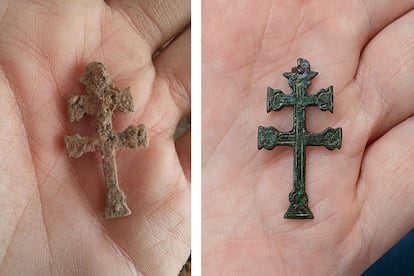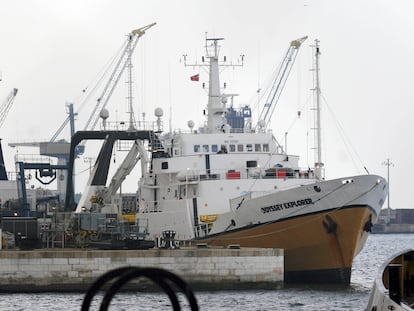How did a 350-year-old Spanish cross get to the US state of Maryland?
There are competing theories about why the Catholic relic, which was made in Caravaca in the north of Spain, wound up in St. Mary’s City, a former European settlement


The traffic signs on Route 235 to St. Mary’s City repeatedly remind drivers that they are on their way to the first European settlement in the US state of Maryland. Along the highway, there are picturesque farms with horse-pulled carts – a sign of the Amish community, who are considered “the second settlers” in these parts. St. Mary’s is a small town of around a thousand people that was founded by the English in 1634. Its main tourist attraction is an archeological site between the Potomac River and Chesapeake river, where buildings dating back to the 17th century have been rebuilt. Last March, after a nearly century-long search, archeologists finally discovered the underground structure they were looking for: a fort the size of a football field.
The fort – which had been described in historic documents – contained ceramics made by Native Americans, oyster shells and a quartzite arrowhead. An eclectic jubilee of objects that proved the archeologists right. Then in October, they found something even more interesting: a copper, double-bar cross dating back 350 years. It was an original Caravaca cross, a religious item made in the southeastern Spanish region of Murcia, in a city called Caravaca de la Cruz. The experts announced the find a few weeks ago, but still have no idea how the relic ended up in St. Mary’s.
When it appeared, I became very emotional because such a small religious object like this means that it was deeply personal to someoneArcheologist Travis Parno
A few meters from the buried fort, archeologist Travis Parno, the director of the Historic St. Mary’s City dig, explains that his team is not used to finding Catholic relics in English colonies. The cross, measuring just four centimeters in length, “is a very particular, very specific religious object,” he says. “It’s not something we have ever found here before. When it appeared, I became very emotional because such a small religious object like this means that it was deeply personal to someone.” Parno is more used to finding fragments of buildings and plates than crosses.
At the beginning of 1630, English colonial administrator George Calvert requested a land grant from King Charles I to create a refuge for persecuted Irish and English Catholics. His work led to the proclamation of the Maryland Toleration Act, which turned the state into one of two English colonies in America where Catholics could practice their faith without reprisal. In the St. Mary’s of the 17th century, Catholics lived alongside Protestants, Jews and other religious followers. Given St. Mary’s – which at the time was the capital of Maryland, now it is Annapolis – enjoyed religious freedom, it is strange that more Catholic pieces have not been uncovered. So far, there is only one other record of a Caravaca Cross in the state, a 300-year-old relic discovered in the Charlestown archeological site.

Researchers have been looking for the exact location of the fort in St. Mary’s since 1930. English archeologist and geophysicist Tom Horsley found the structure thanks to magnetometry, a sophisticated technique that uses a magnetometer to measure the magnetic field. For Horsley, the cross was “clearly a valuable possession” for the person who brought it from England, perhaps to trade with a Native American. “It’s very difficult to explain,” he says by phone. “With archeology, we can reach theories and write suggestions, but we will never know for sure.”
The supposed powers of the Caravaca cross – which was said to protect the holder from ills, in particular storms and lightning – combined with the fact that Roman pontiffs favored its bearers, “triggered a significant demand for the pieces,” according to Indalecio Pozo Martínez, the head of the Vera Cruz de Caravaca Museum. “This, in large part, explains the presence of Caravaca crosses in many places and their appearances in archeological sites from Prague to Maryland.”
Jesuit missionary
Parno is not ready to commit to any explanation, but believes the most likely scenario is that the cross was brought to St. Mary’s by an English Catholic or a Jesuit missionary: “We know that the Jesuits had strong ties to Spain and that at the beginning of the 17th century, Caravaca crosses were present across Europe.” The crosses were also present in other territories in America, as well as some colonies in the Far East and Africa. Before setting sail to the New World, the Italian Jesuit Eusebio Francisco Kino issued an order for the purchase of “30 or 40 dozens of small Spanish or Caravaca crosses” to “give to the natives,” according to his Epistolario letters, which were cited by Pozo Martínez in an email.
It’s expected that the Historic St. Mary’s City will open a new visitors center in 2024, where the Caravaca cross will be given pride of place among the other valuable objects discovered in the fort. The researchers have already collected 100,000 pieces and, according to Parno, they hope to continue to excavate the area for the next 10 to 20 years. Since archeologists first began investigating the site half a century ago, 6.5 million objects have been found. And they have only combed through 5% of its 800 hectares.
Tu suscripción se está usando en otro dispositivo
¿Quieres añadir otro usuario a tu suscripción?
Si continúas leyendo en este dispositivo, no se podrá leer en el otro.
FlechaTu suscripción se está usando en otro dispositivo y solo puedes acceder a EL PAÍS desde un dispositivo a la vez.
Si quieres compartir tu cuenta, cambia tu suscripción a la modalidad Premium, así podrás añadir otro usuario. Cada uno accederá con su propia cuenta de email, lo que os permitirá personalizar vuestra experiencia en EL PAÍS.
¿Tienes una suscripción de empresa? Accede aquí para contratar más cuentas.
En el caso de no saber quién está usando tu cuenta, te recomendamos cambiar tu contraseña aquí.
Si decides continuar compartiendo tu cuenta, este mensaje se mostrará en tu dispositivo y en el de la otra persona que está usando tu cuenta de forma indefinida, afectando a tu experiencia de lectura. Puedes consultar aquí los términos y condiciones de la suscripción digital.
More information
Archived In
Últimas noticias
Welcome to the post-religion era: The idea of Christianity as the absolute truth has become obsolete
‘I thought you would like it’: The risky sexual practice popularized by TV shows and TikTok
The digitalization of tourism: ‘They promise experiences and gave us the worst possible one’
Mexican peso defies uncertainty with forecasts of a new period of stability in 2026
Most viewed
- Sinaloa Cartel war is taking its toll on Los Chapitos
- Reinhard Genzel, Nobel laureate in physics: ‘One-minute videos will never give you the truth’
- Oona Chaplin: ‘I told James Cameron that I was living in a treehouse and starting a permaculture project with a friend’
- Why the price of coffee has skyrocketed: from Brazilian plantations to specialty coffee houses
- Silver prices are going crazy: This is what’s fueling the rally










































